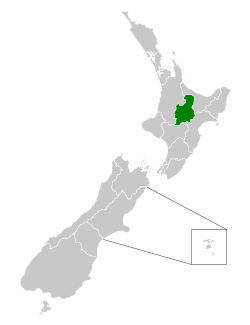Lakes District Health Board
The Lakes District Health Board (Lakes DHB) is a district health board with the focus on providing healthcare to the area covered by Taupō and Rotorua districts in New Zealand.
 Location of the Lakes DHB (green) in New Zealand | |
| Formation | 1 January 2001 |
|---|---|
| Founder | New Zealand Government |
| Legal status | Active |
| Purpose | DHB |
| Services | Health and disability services |
Parent organization | Ministry of Health |
| Website | www |
History
The Lakes District Health Board, like most other district health boards, came into effect on 1 January 2001 established by the New Zealand Public Health and Disability Act 2000.[1]
Geographic area
The area covered by the Lakes District Health Board is defined in Schedule 1 of the New Zealand Public Health and Disability Act 2000 and based on territorial authority and ward boundaries as constituted as at 1 January 2001.[2] The area can be adjusted through an Order in Council.[3]
Governance
The initial board was fully appointed. Since the 2001 local elections, the board has been partially elected (seven members) and in addition, up to four members get appointed by the Minister of Health. The minister also appoints the chairperson and deputy-chair from the pool of eleven board members.[4]
Demographics
| Year | Pop. | ±% p.a. |
|---|---|---|
| 2006 | 98,319 | — |
| 2013 | 98,190 | −0.02% |
| 2018 | 109,080 | +2.13% |
| Source: [5] | ||
Lakes DHB served a population of 109,080 at the time of the 2018 New Zealand census, an increase of 10,890 people (11.1%) since the 2013 census, and an increase of 10,761 people (10.9%) since the 2006 census. There were 38,886 households. There were 53,670 males and 55,407 females, giving a sex ratio of 0.97 males per female. Of the total population, 23,766 people (21.8%) were aged up to 15 years, 20,220 (18.5%) were 15 to 29, 47,655 (43.7%) were 30 to 64, and 17,439 (16.0%) were 65 or older. Figures may not add up to the total due to rounding.
Ethnicities were 67.8% European/Pākehā, 36.6% Māori, 4.7% Pacific peoples, 7.9% Asian, and 1.7% other ethnicities. People may identify with more than one ethnicity.
The percentage of people born overseas was 17.4, compared with 27.1% nationally.
Although some people objected to giving their religion, 50.6% had no religion, 34.3% were Christian, and 8.2% had other religions.
Of those at least 15 years old, 14,238 (16.7%) people had a bachelor or higher degree, and 16,194 (19.0%) people had no formal qualifications. The median income was $28,800. The employment status of those at least 15 was that 41,505 (48.6%) people were employed full-time, 13,392 (15.7%) were part-time, and 4,353 (5.1%) were unemployed.[5]
Notes
- Rudman, Brian (13 February 2012). "Brian Rudman: Three health boards must marry and economise". The New Zealand Herald. Retrieved 3 May 2020.
- Public Health and Disability Act 2000, Schedule 1.
- Public Health and Disability Act 2000, Section 19.
- "District health boards". Ministry of Health. 12 February 2020. Retrieved 3 May 2020.
- "Statistical area 1 dataset for 2018 Census". Statistics New Zealand. March 2020. Lakes DHB (06).
References
- New Zealand Public Health and Disability Act 2000, Parliamentary Counsel Office, 2000, retrieved 3 May 2020